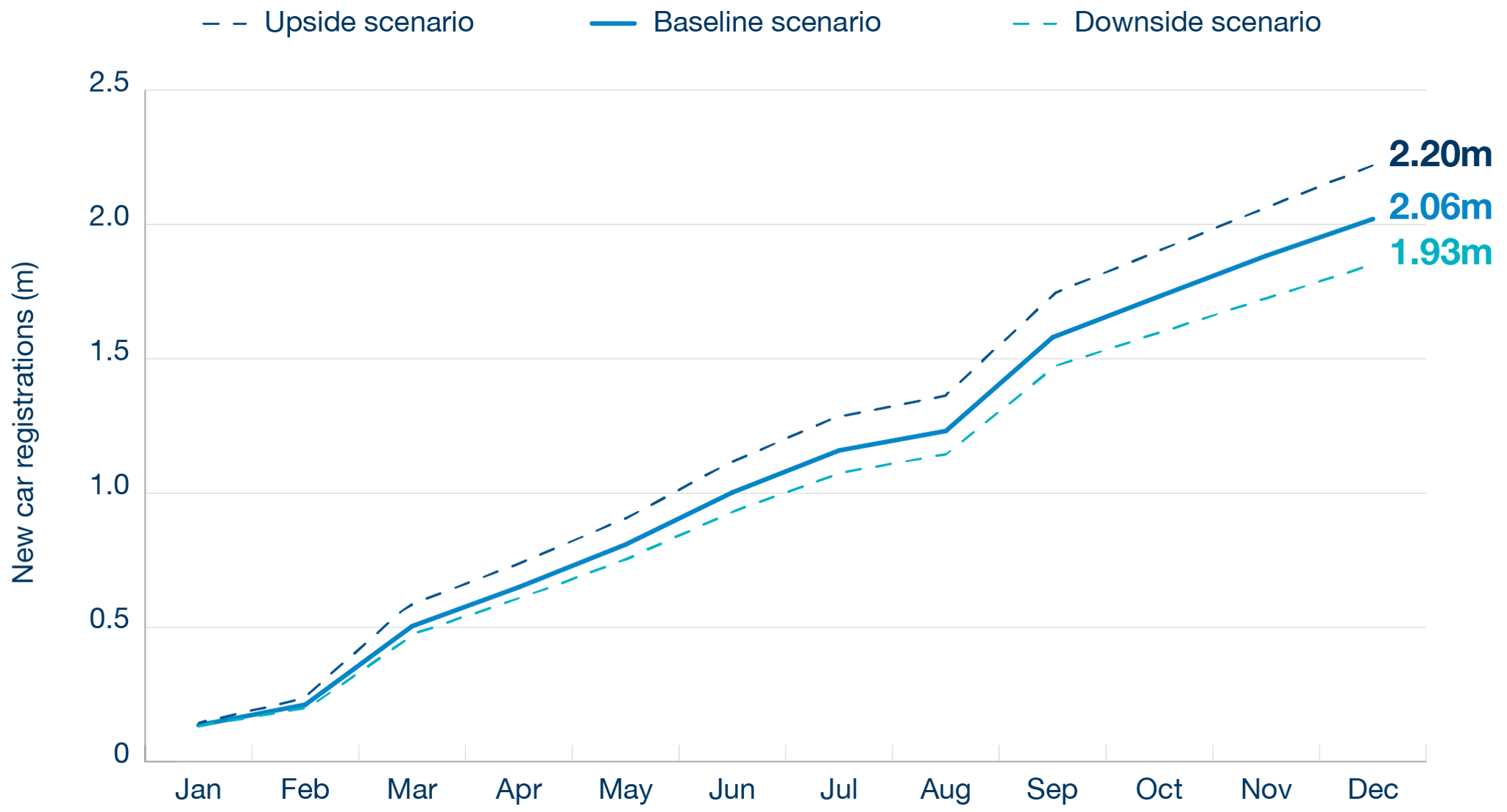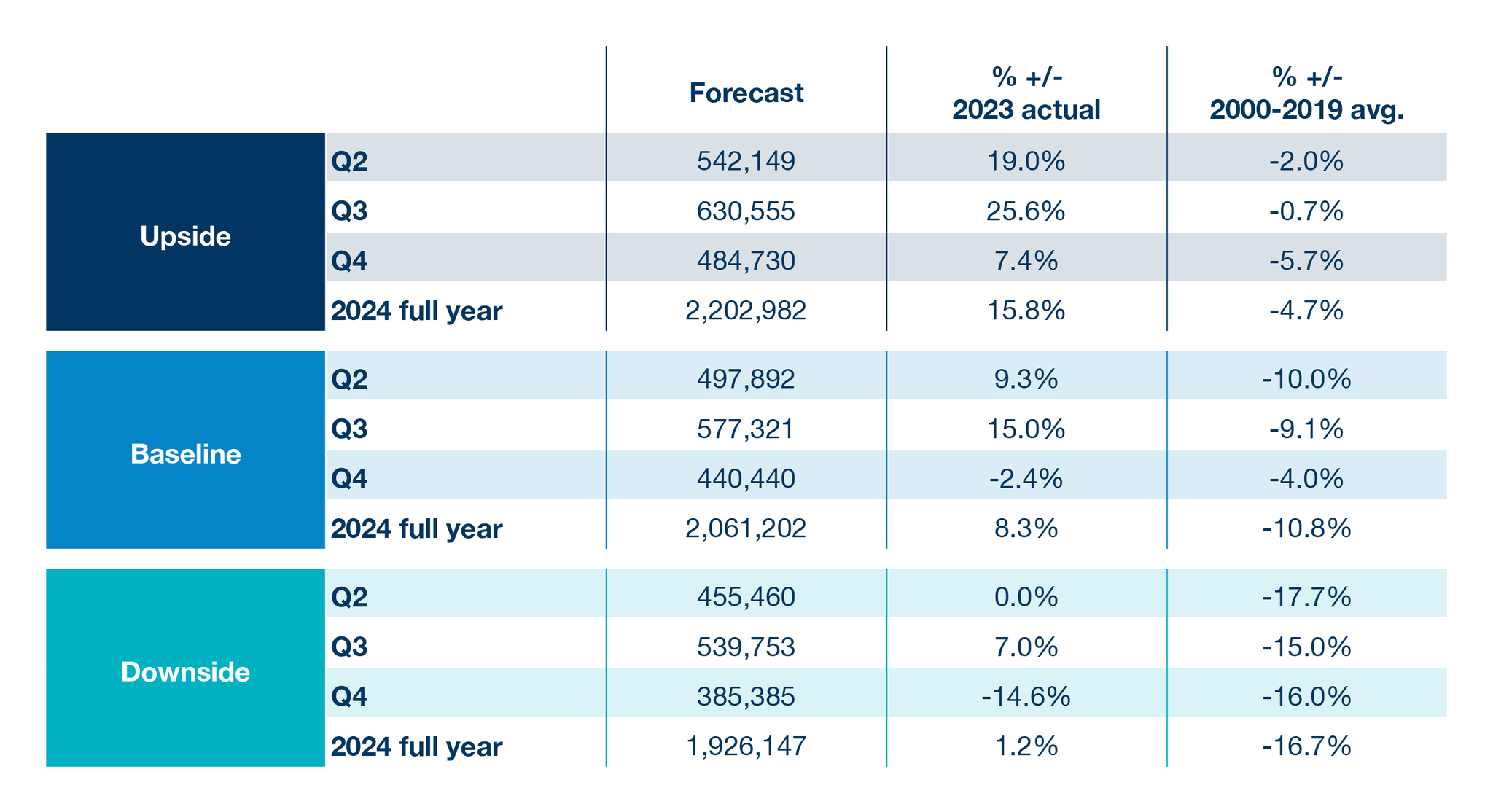
Philip Nothard
INSIGHT DIRECTOR

3 min read

Building on recent new car figures, the market factors described here and in line with previous Cox Automotive forecasts, we have adjusted our new car registration forecasts. They are broken up into three scenarios – upside, baseline, and downside – each with its justification below. The baseline is, we believe, the most likely scenario to materialise
2024 New Car Registrations

Cox Automotive New Car Registration Forecast

Upside scenario
A robust economic rebound in the latter part of the year cultivates enhanced consumer confidence, successful market entries, seamless adoption of the agency model and the advancement of sustainable transportation policies.
An economic resurgence spurs a swift nationwide economic recovery, surpassing GDP growth projections set by the UK government and the Bank of England (BoE). This rapid upswing triggers a notable decrease in inflation rates, leading to a corresponding drop in interest rates. As a result, personal disposable income per capita sees a significant upturn, igniting a notable growth in consumer confidence. Notably, heightened consumer confidence correlates positively with increased investments in new and used vehicles.
New entrants quickly carve out robust consumer and business brand recognition backed by substantial product volumes. Their presence catalyses market expansion and gradually chips away at established manufacturers' market share. Of particular note are the significant contributions made by Chinese and Vietnamese manufacturers to this upward trajectory.
The adoption of the agency sales model meets with minimal disruption to established manufacturers' market share and distribution channels. Transition manages to achieve a delicate equilibrium between ICE vehicles and EVs, ensuring broad customer acceptance.
Amid a flourishing automotive market, policies, including the Zero Emission Vehicle (ZEV) mandate, are seamlessly implemented with minimal disruption to market dynamics. They harmonise with industry trends and facilitate a smooth transition towards cleaner, more sustainable transport options.
Baseline scenario
In this scenario, economic pressures persist alongside agency model transition challenges and issues posed by UK and European legislation changes.
Consumer spending remains subdued as the economy grapples with ongoing challenges. Inflation and interest rates are expected to ease at a slower pace than initially forecast, adding to uncertainty surrounding living costs and energy prices. Consequently, consumer confidence remains low. Despite these hurdles, a gradual improvement in consumer confidence is anticipated, with sustained demand in the fleet market for new vehicles.
The postponement of agency model adoption by many OEMs in 2024 highlights the need for clarity regarding its financial viability. More OEMs are expected to gradually move toward the agency model in its purest form or via hybrid variants. This shift represents a departure from the traditional 'push' model of the franchised arrangement to a consumer 'pull' model. However, implementing true agency models reduces the number of vehicles in the market.
Global production levels surpassed forecasts in 2023, raising sustainability concerns. The UK's emphasis on implementing the Zero Emission Vehicle (ZEV) mandate for OEMs is expected to impact market performance significantly. However, the dissonance between high global production and potentially unattainable targets for the 2024 ZEV mandate raises doubts about OEM commitments to the UK automotive sector. Additionally, the challenges associated with reducing ICE vehicle production to meet the mandated share for EVs further complicates the situation.
Downside scenario
In the downside scenario, Persistent low consumer confidence, subdued business activity, challenges arising from new legislation and notable difficulties transitioning to the agency model are prominent.
The economy experiences further deterioration as unchecked inflation persists despite government measures. This places significant strain on consumer spending and the cost of living. The looming possibility of interest rate hikes or minimal prospects for reductions threatens to escalate costs for consumers and businesses. Consequently, consumer confidence declines, potentially pushing the Business PMI (Purchasing Managers' Index) below the critical threshold of 50, indicating a contraction in business activity.
Despite the continuation of the ZEV mandate, consumer enthusiasm for EVs diminishes due to prolonged government inaction on support and incentives. Moreover, the widening gap in the cost of entry between new and used vehicles further strains the financial viability of retailers.
Legacy OEMs encounter significant complexities in transitioning to the agency model. Adoption rates fall short of initial projections and the new model disrupts established consumer purchasing processes, leading to uncertainty and reluctance among buyers.






